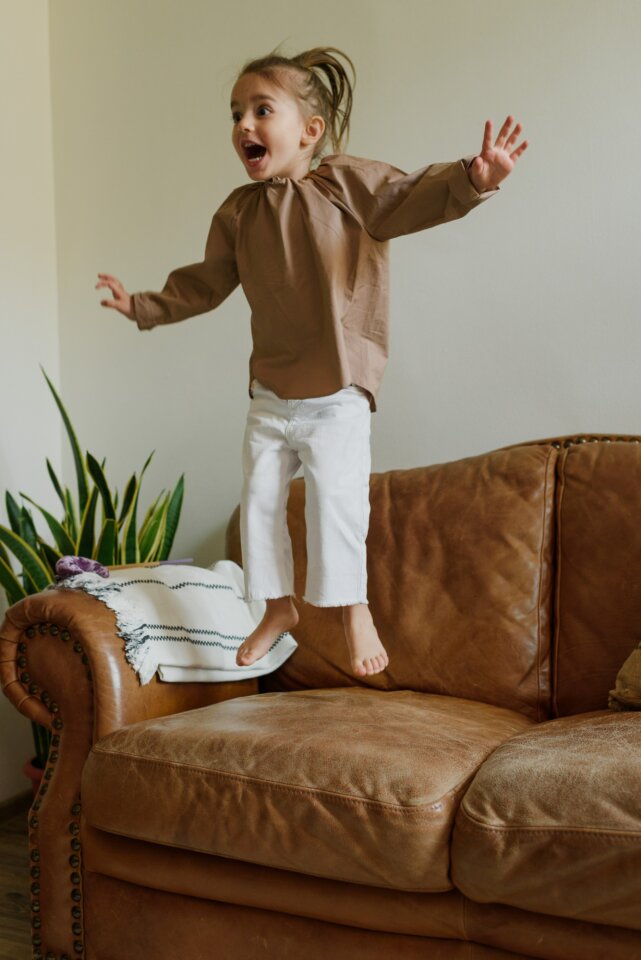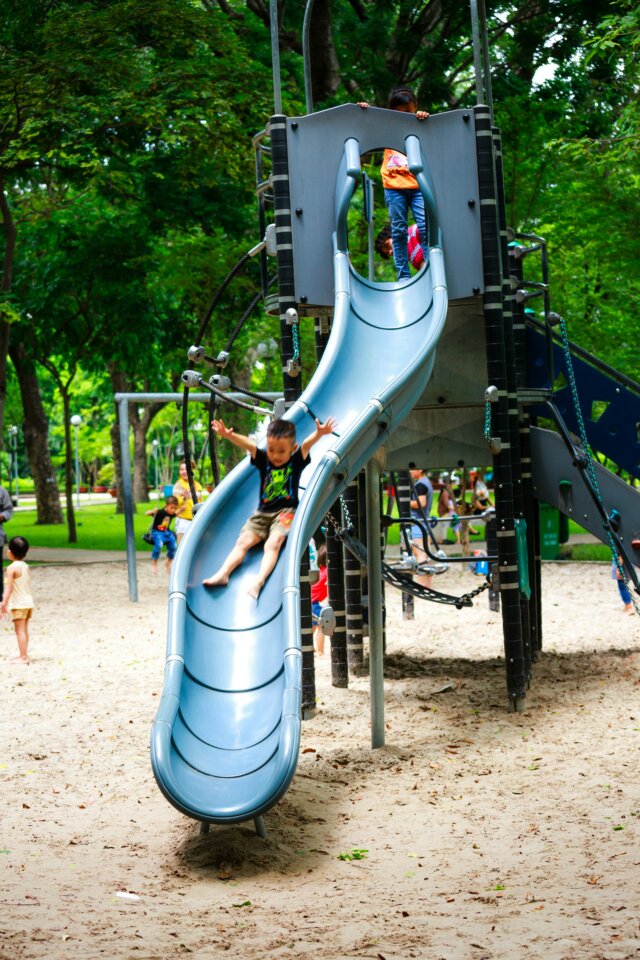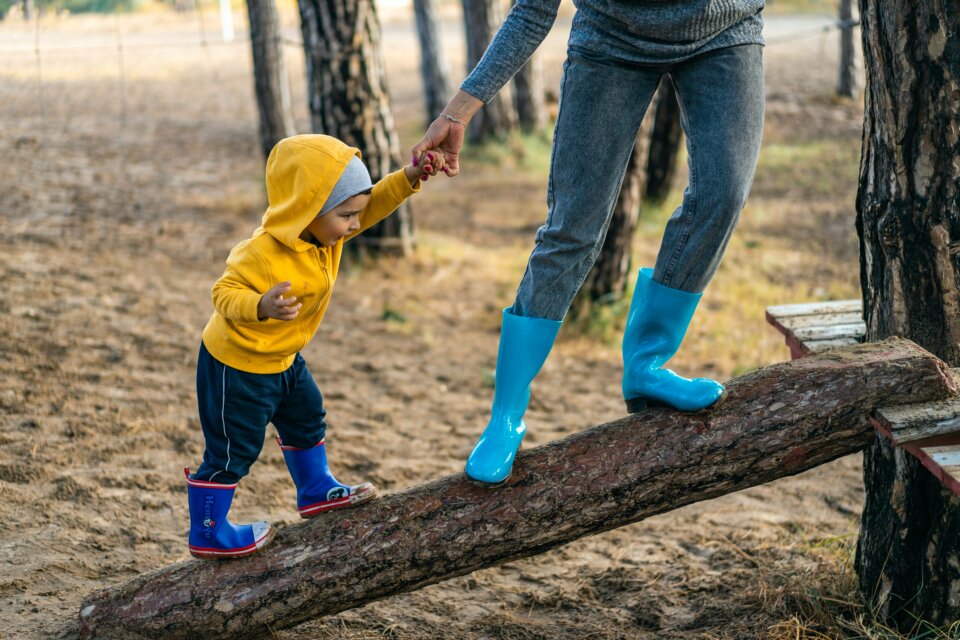Kids & Company Blog
Encouraging Gross Motor Play
Children are continually building their repertoire of gross motor skills that they developed in the first few years of life — such as jumping, running, kicking and throwing balls. As they develop, the complexity of these skills increases — with movements requiring a greater degree of balance, strength, and coordination. For example, children learn to jump on two feet before they learn to jump on one foot. Though some gross motor skills are innate and develop naturally, other times children learn these skills through exposure. Child care, kindergarten, extracurricular classes, and public environments (such as playgrounds) are great places for children to develop these skills, parents and caregivers can also help to provide opportunities to develop children’s gross motor skills — right from home!

A great way to help a child’s physical development is through something they are already doing plenty of — PLAY (more specifically, “purposeful play”). Purposeful play includes incorporating specific movements into fun activities with the goal of developing a specific gross motor skill. Purposeful play can be unplanned and self-directed (such as playing on a playground structure or running through a field), or planned through more structured games and activities. You can integrate purposeful play into your child’s day by providing exposure to activities and environments that encourage this. Below are some activity ideas based on your child’s age:
Activities to promote Purposeful Play:
- Games: Incorporate different types of games into your day! While indoors, you can try a game of hopscotch to work on double or single leg jumping. You can use tiles on the floor and have your child jump with two feet forward (for a 3 year old), on the spot 3–5 times (for a 4 year old), or forward on to different tiles (for a 5 year old). To work on body awareness and single-leg balance, you can try a game of freeze dance. Every time the music stops, your child has to stand on either foot for 3–5 seconds (for a 3 year old), 5–10 seconds (for a 4 year old), or 10+ seconds (for a 5 year old). When looking to do these skills outdoors, you can encourage jumping over obstacles (such as sticks) or balancing on one foot on different surfaces — such as gravel, sand, or on a grassy hill.
- Obstacle courses: This is a great way to engage your child by getting them to help invent games that will be motivating for them! Obstacle courses can be set up to work on balance. Play “the floor is lava” by placing couch cushions on the floor as “rocks” and so they need to walk across them to avoid the floor, or say that the couch cushions are islands to avoid the “sharks” on the floor! The obstacles can also be tailored to match the age of your child and/or the skills they are working on. For 3 year olds, encourage jumping with two feet over small obstacles (eg. tissue boxes), and for 4–5 year olds, the obstacle to jump over can have a larger height (eg. square bucket), or they can hop with one foot over a tissue box instead of jumping. In addition, something as simple as walking up and down the stairs can be an activity by placing a puzzle board at the top of the stairs, and the pieces at the bottom. Then put down two different colours of painter’s tape on alternating steps, to encourage reciprocal stepping up the stairs as they go up and down to get the puzzle pieces.
- Family “challenges”: Have the whole family join in the fun by creating challenges for everyone to take part in! Examples include: Who can froggy jump the farthest? Can you walk like a crab all the way across the living room? Who can stand on one foot the longest? Can you run around the park to find the biggest leaf on the ground?

Environments to promote Gross Motor Play:
Spaces that encourage gross motor skill development through play are often wide and open to allow for movement but also have features that children can jump, climb, step and hang off of. Inside, encourage playing in more open areas such as the living room or rec room. In these spaces, be creative with furniture or fixtures such as stairs, couches, chairs, cushions, and lines between different floor surfaces. Be mindful of hazards such as clutter, wires, or sharp edges of furniture when considering the indoor space, and make adjustments as you are able (such as moving the coffee table out of the way) to keep the activity safe.
Outside, you can make use of the backyard, courtyard or driveway, or explore the neighbourhood and visit a variety of different play structures, parks, forest trails, fields, beaches and nature reserves. Some of the features to encourage active movement in these spaces may be more obvious (such as monkey bars), but other natural features can include steps, curbs, logs, and stepping stones. These spaces also offer various different surfaces that can challenge our balance and movement patterns differently than on flat ground such as grass, mulch, sand, mud and stones.
Outdoor play is particularly beneficial to promote gross motor development. The space itself allows for more freedom for big movements like running and jumping, and allows for more trial-and-error of skills such as kicking a ball (without worry of hitting a wall or object that we don’t want to get broken!). Outdoor play also allows children to work on whole body movements and spatial awareness in environments that are less controlled than indoors (eg. changes in weather can make some surfaces more slippery or more grippy). Further, children are exposed to performing gross motor skills on surfaces that we don’t find inside, thus adding an extra challenge to their strength and balance.

If you have any questions or are in need of support connect with us on Instagram @kidsphysio or visit us at www.kidsphysio.ca.
This blog was written by our guest author Colleen Greasley, Physiotherapist from Kids Physio. Kids Physio provides pediatric physiotherapy services across the country; as babies, kids, and teens function differently from adults, and our spaces and team are equipped to provide the highest quality physiotherapy care, delivered in a FUN and engaging way.
Posted on: Thursday March 30th, 2023
Posted by: Kids & Company
Calgary
Calgary
Calgary
Calgary
Calgary
Edmonton
Cochrane
Red Deer
Calgary
Calgary
Okotoks
Calgary
Calgary
Calgary
Calgary
Edmonton
St. Albert
Edmonton
Edmonton
Edmonton
Edmonton
Edmonton
Edmonton
Edmonton
St. Albert
Edmonton
Edmonton
Sylvan Lake
Edmonton
Sherwood Park
Edmonton
Calgary
Edmonton
Calgary
Edmonton
Kamloops
Langley
Langley
New Westminster
North Vancouver
Richmond
Vancouver
Victoria
Victoria
Port Moody
Surrey
Surrey
Surrey
North Vancouver
Nanaimo
Surrey
Coquitlam
Burnaby
Port Coquitlam
Vancouver
Maple Ridge
Maple Ridge
Maple Ridge
Mission
Maple Ridge
Maple Ridge
Maple Ridge
Maple Ridge
Mission
Mission
Maple Ridge
Maple Ridge
Chicago
Chicago
Chicago
Chicago
Schaumburg
Chicago
Winnipeg
Abington
Canton
Quincy
West Quincy
Braintree
Braintree
Walpole
East Walpole
Brighton
Brookline
Jamaica Plain
Jamaica Plain
Cambridge
Needham
Newton Highlands
Newton
Cambridge
Boston
Randolph
Kingston
St. Peters
Lake St. Louis
Troy
O'Fallon
St. Charles
Lake St. Louis
St. Peters
O'Fallon
Howell Township
Freehold Township
Manalapan Township
Stratford
Marlton
West Deptford
Bedford
Dartmouth
Halifax
Bedford
Hammonds Plains
Lower Sackville
Eastern Passage
Avon Lake
Beachwood
Hudson
Medina
Strongsville
Cleveland
Westlake
Aurora
Burlington
Burlington
Etobicoke
Etobicoke
Hamilton
London
Milton
Mississauga
Ottawa
Richmond Hill - Corporate office (No child care services)
Toronto
Toronto
Toronto
Toronto
Toronto
Waterloo
Kanata
Oakville
Oakville
Toronto
Whitby
Toronto
Mississauga
Ottawa
Toronto
Toronto
Toronto
Brampton
Stoney Creek
Toronto
Nepean
Burlington
Burlington
Oakville
Waterdown
Oakville
Pittston
Wilkes-Barre
Exeter
Old Forge
Dover
Harrisburg
Harrisburg
Harrisburg
Hummelstown
Palmyra
York
York
York
Sweet Kiddles Avon Lake, part of the Kids & Company Family
Abington
Aurora
Sweet Kiddles Beachwood, part of the Kids & Company Family
Bedford (Dellridge Lane)
Larry Uteck (Southgate Dr)
Pine Village South End, by Kids & Company
Braintree 1
Braintree 2
Brampton
Pine Village Brighton, by Kids & Company
Pine Village Brookline, by Kids & Company
Burlington Children’s Centre
Burloak
Appleby
Beacon Hill
Brightstart Burnaby, by Kids & Company
Bow Trail
Livingston
Midlake
Millrise
Royal Oak
Britannia Crossing
Marda Loop
Evanston
Beltline
Aviation Crossing
Gulf Canada Square
Royal Oak Out of School Care and Child Care
Glendeer: New – Open for Enrollment
Pine Village Kendall Square, by Kids & Company
Pine Village Porter Square, by Kids & Company
Canton
Jackson
Lincoln Park
Harrison
West Loop
Fulton
Sweet Kiddles University Circle, part of the Kids & Company Family
Cochrane
Brightstart Coquitlam, by Kids & Company
Dartmouth
Dover
Walpole North
Eastern Passage
Ellerslie
Edmonton Ice District
Baturyn
Diamond
Friendly Frog
Meadowlark Park
St. Charles
St. Dominic
Sunshine Factory
Tamarack
Jagare Ridge
Horse Hill
Fraser
Century Park: New – Open for Enrollment
Grandview Heights
Islington
Etobicoke (Bloor & Islington)
ABC Kiddie Kampus Exeter, by Kids & Company
Apple Hill Academy Freehold by Kids & Company
Halifax
Hamilton
Hammonds Plains
Route 39
Schaffner
Swatara
Apple Hill Academy Howell by Kids & Company
Sweet Kiddles Hudson, part of the Kids & Company Family
Hummelstown
Pine Village JP Revere, by Kids & Company
Pine Village JP South Street, by Kids & Company
Kamloops
Eagleson (South Kanata)
Crayon College, by Kids & Company
Tyke Town Lake St. Louis, by Kids & Company
ABC Lake St. Louis, by Kids & Company
Kids World
Langley (200th St.)
London Richmond
Sackville
Apple Hill Academy Manalapan by Kids & Company
Little Willows 119 Avenue, by Kids & Company
Little Willows Dewdney House (Infant/Toddler and 3-5), by Kids & Company
Little Willows Dewdney Church (Preschool/OSC/3-5), by Kids & Company
Little Willows Edge, by Kids & Company
Little Willows Webster’s Corner, by Kids & Company
Little Willows Harry Hooge, by Kids & Company
Little Willows Alouette, by Kids & Company
Little Willows Silver Valley, by Kids & Company
Little Willows Whonnock, by Kids & Company
Under The Sun Marlton, part of the Kids & Company Family
Sweet Kiddles Medina, part of the Kids & Company Family
Milton
Little Willows Lougheed, by Kids & Company
Little Willows Stave Falls, by Kids & Company
Little Willows Briskham, by Kids & Company
Robert Speck Parkway
Mississauga Gateway Centre
Nanaimo
Pine Village Needham, by Kids & Company
Ottawa Barrhaven
New Westminster
Pine Village West Newton, by Kids & Company
Pine Village Newton Highlands, by Kids & Company
North Vancouver
North Van Esplanade
O’Fallon South
ABC O’Fallon, by Kids & Company
Oakville Cornwall
Oakville Dundas
Joshua Creek
Oakville West (3537 Wyecroft Rd)
Okotoks
ABC Kiddie Kampus Old Forge, by Kids & Company
Ottawa Albert
Ottawa Westboro
Palmyra
ABC Kiddie Kampus Pittston, by Kids & Company
Brightstart Port Coquitlam, by Kids & Company
Port Moody
Marina Bay
Randolph
Red Deer
Richmond
Head Office
Schaumburg
Sherwood Park
St. Albert North
St. Albert Grandin
ABC St. Charles, by Kids & Company
Tyke Town St. Peters, by Kids & Company
ABC St. Peters, by Kids & Company
Stoney Creek
Under The Sun Stratford, part of the Kids & Company Family
Sweet Kiddles Strongsville, part of the Kids & Company Family
Morgan Crossing
Surrey Professional Centre
King George
Brightstart Cloverdale, by Kids & Company
Sylvan Lake
Bloor Christie
Bloor (Bloor St. East)
Consumers
Finch
Front
Scotia Plaza
Stockyards
St. Andrew’s Church
Liberty Village
Rosedale
Queen West
Tyke Town Troy, by Kids & Company
Vancouver West
Cambie
Langford
Victoria
Walpole South
Waterdown
Tech Town
Under The Sun West Deptford, part of the Kids & Company Family
West Quincy
Sweet Kiddles Westlake, part of the Kids & Company Family
Whitby
ABC Kiddie Kampus East Mountain, by Kids & Company
Winnipeg
West York
Queen Street
Keystone Early Learning Academy, part of the Kids & Company Family
Calgary
Calgary
Calgary
Calgary
Calgary
Edmonton
Cochrane
Red Deer
Calgary
Calgary
Okotoks
Calgary
Calgary
Calgary
Calgary
Edmonton
St. Albert
Edmonton
Edmonton
Edmonton
Edmonton
Edmonton
Edmonton
Edmonton
St. Albert
Edmonton
Edmonton
Sylvan Lake
Edmonton
Sherwood Park
Edmonton
Calgary
Edmonton
Calgary
Edmonton
Kamloops
Langley
Langley
New Westminster
North Vancouver
Richmond
Vancouver
Victoria
Victoria
Port Moody
Surrey
Surrey
Surrey
North Vancouver
Nanaimo
Surrey
Coquitlam
Burnaby
Port Coquitlam
Vancouver
Maple Ridge
Maple Ridge
Maple Ridge
Mission
Maple Ridge
Maple Ridge
Maple Ridge
Maple Ridge
Mission
Mission
Maple Ridge
Maple Ridge
Chicago
Chicago
Chicago
Chicago
Schaumburg
Chicago
Winnipeg
Abington
Canton
Quincy
West Quincy
Braintree
Braintree
Walpole
East Walpole
Brighton
Brookline
Jamaica Plain
Jamaica Plain
Cambridge
Needham
Newton Highlands
Newton
Cambridge
Boston
Randolph
Kingston
St. Peters
Lake St. Louis
Troy
O'Fallon
St. Charles
Lake St. Louis
St. Peters
O'Fallon
Howell Township
Freehold Township
Manalapan Township
Stratford
Marlton
West Deptford
Bedford
Dartmouth
Halifax
Bedford
Hammonds Plains
Lower Sackville
Eastern Passage
Avon Lake
Beachwood
Hudson
Medina
Strongsville
Cleveland
Westlake
Aurora
Burlington
Burlington
Etobicoke
Etobicoke
Hamilton
London
Milton
Mississauga
Ottawa
Richmond Hill - Corporate office (No child care services)
Toronto
Toronto
Toronto
Toronto
Toronto
Waterloo
Kanata
Oakville
Oakville
Toronto
Whitby
Toronto
Mississauga
Ottawa
Toronto
Toronto
Toronto
Brampton
Stoney Creek
Toronto
Nepean
Burlington
Burlington
Oakville
Waterdown
Oakville
Pittston
Wilkes-Barre
Exeter
Old Forge
Dover
Harrisburg
Harrisburg
Harrisburg
Hummelstown
Palmyra
York
York
York
Sweet Kiddles Avon Lake, part of the Kids & Company Family
Abington
Aurora
Sweet Kiddles Beachwood, part of the Kids & Company Family
Bedford (Dellridge Lane)
Larry Uteck (Southgate Dr)
Pine Village South End, by Kids & Company
Braintree 1
Braintree 2
Brampton
Pine Village Brighton, by Kids & Company
Pine Village Brookline, by Kids & Company
Burlington Children’s Centre
Burloak
Appleby
Beacon Hill
Brightstart Burnaby, by Kids & Company
Bow Trail
Livingston
Midlake
Millrise
Royal Oak
Britannia Crossing
Marda Loop
Evanston
Beltline
Aviation Crossing
Gulf Canada Square
Royal Oak Out of School Care and Child Care
Glendeer: New – Open for Enrollment
Pine Village Kendall Square, by Kids & Company
Pine Village Porter Square, by Kids & Company
Canton
Jackson
Lincoln Park
Harrison
West Loop
Fulton
Sweet Kiddles University Circle, part of the Kids & Company Family
Cochrane
Brightstart Coquitlam, by Kids & Company
Dartmouth
Dover
Walpole North
Eastern Passage
Ellerslie
Edmonton Ice District
Baturyn
Diamond
Friendly Frog
Meadowlark Park
St. Charles
St. Dominic
Sunshine Factory
Tamarack
Jagare Ridge
Horse Hill
Fraser
Century Park: New – Open for Enrollment
Grandview Heights
Islington
Etobicoke (Bloor & Islington)
ABC Kiddie Kampus Exeter, by Kids & Company
Apple Hill Academy Freehold by Kids & Company
Halifax
Hamilton
Hammonds Plains
Route 39
Schaffner
Swatara
Apple Hill Academy Howell by Kids & Company
Sweet Kiddles Hudson, part of the Kids & Company Family
Hummelstown
Pine Village JP Revere, by Kids & Company
Pine Village JP South Street, by Kids & Company
Kamloops
Eagleson (South Kanata)
Crayon College, by Kids & Company
Tyke Town Lake St. Louis, by Kids & Company
ABC Lake St. Louis, by Kids & Company
Kids World
Langley (200th St.)
London Richmond
Sackville
Apple Hill Academy Manalapan by Kids & Company
Little Willows 119 Avenue, by Kids & Company
Little Willows Dewdney House (Infant/Toddler and 3-5), by Kids & Company
Little Willows Dewdney Church (Preschool/OSC/3-5), by Kids & Company
Little Willows Edge, by Kids & Company
Little Willows Webster’s Corner, by Kids & Company
Little Willows Harry Hooge, by Kids & Company
Little Willows Alouette, by Kids & Company
Little Willows Silver Valley, by Kids & Company
Little Willows Whonnock, by Kids & Company
Under The Sun Marlton, part of the Kids & Company Family
Sweet Kiddles Medina, part of the Kids & Company Family
Milton
Little Willows Lougheed, by Kids & Company
Little Willows Stave Falls, by Kids & Company
Little Willows Briskham, by Kids & Company
Robert Speck Parkway
Mississauga Gateway Centre
Nanaimo
Pine Village Needham, by Kids & Company
Ottawa Barrhaven
New Westminster
Pine Village West Newton, by Kids & Company
Pine Village Newton Highlands, by Kids & Company
North Vancouver
North Van Esplanade
O’Fallon South
ABC O’Fallon, by Kids & Company
Oakville Cornwall
Oakville Dundas
Joshua Creek
Oakville West (3537 Wyecroft Rd)
Okotoks
ABC Kiddie Kampus Old Forge, by Kids & Company
Ottawa Albert
Ottawa Westboro
Palmyra
ABC Kiddie Kampus Pittston, by Kids & Company
Brightstart Port Coquitlam, by Kids & Company
Port Moody
Marina Bay
Randolph
Red Deer
Richmond
Head Office
Schaumburg
Sherwood Park
St. Albert North
St. Albert Grandin
ABC St. Charles, by Kids & Company
Tyke Town St. Peters, by Kids & Company
ABC St. Peters, by Kids & Company
Stoney Creek
Under The Sun Stratford, part of the Kids & Company Family
Sweet Kiddles Strongsville, part of the Kids & Company Family
Morgan Crossing
Surrey Professional Centre
King George
Brightstart Cloverdale, by Kids & Company
Sylvan Lake
Bloor Christie
Bloor (Bloor St. East)
Consumers
Finch
Front
Scotia Plaza
Stockyards
St. Andrew’s Church
Liberty Village
Rosedale
Queen West
Tyke Town Troy, by Kids & Company
Vancouver West
Cambie
Langford
Victoria
Walpole South
Waterdown
Tech Town
Under The Sun West Deptford, part of the Kids & Company Family
West Quincy
Sweet Kiddles Westlake, part of the Kids & Company Family
Whitby
ABC Kiddie Kampus East Mountain, by Kids & Company
Winnipeg
West York
Queen Street
Keystone Early Learning Academy, part of the Kids & Company Family




